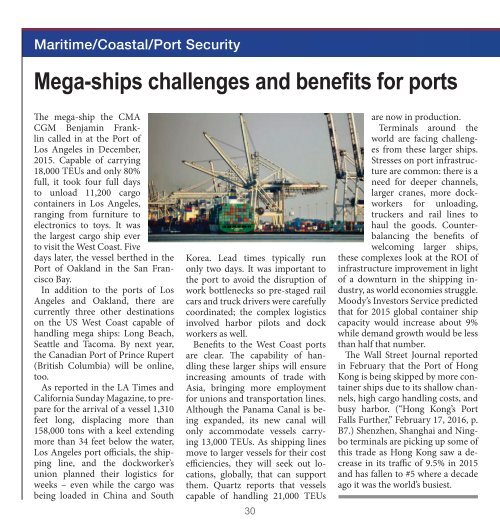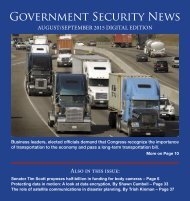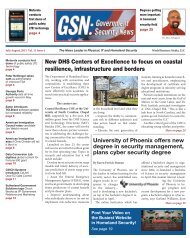GSN Digital Edition April 2016
Create successful ePaper yourself
Turn your PDF publications into a flip-book with our unique Google optimized e-Paper software.
Maritime/Coastal/Port Security<br />
Mega-ships challenges and benefits for ports<br />
The mega-ship the CMA<br />
CGM Benjamin Franklin<br />
called in at the Port of<br />
Los Angeles in December,<br />
2015. Capable of carrying<br />
18,000 TEUs and only 80%<br />
full, it took four full days<br />
to unload 11,200 cargo<br />
containers in Los Angeles,<br />
ranging from furniture to<br />
electronics to toys. It was<br />
the largest cargo ship ever<br />
to visit the West Coast. Five<br />
days later, the vessel berthed in the<br />
Port of Oakland in the San Francisco<br />
Bay.<br />
In addition to the ports of Los<br />
Angeles and Oakland, there are<br />
currently three other destinations<br />
on the US West Coast capable of<br />
handling mega ships: Long Beach,<br />
Seattle and Tacoma. By next year,<br />
the Canadian Port of Prince Rupert<br />
(British Columbia) will be online,<br />
too.<br />
As reported in the LA Times and<br />
California Sunday Magazine, to prepare<br />
for the arrival of a vessel 1,310<br />
feet long, displacing more than<br />
158,000 tons with a keel extending<br />
more than 34 feet below the water,<br />
Los Angeles port officials, the shipping<br />
line, and the dockworker’s<br />
union planned their logistics for<br />
weeks – even while the cargo was<br />
being loaded in China and South<br />
Korea. Lead times typically run<br />
only two days. It was important to<br />
the port to avoid the disruption of<br />
work bottlenecks so pre-staged rail<br />
cars and truck drivers were carefully<br />
coordinated; the complex logistics<br />
involved harbor pilots and dock<br />
workers as well.<br />
Benefits to the West Coast ports<br />
are clear. The capability of handling<br />
these larger ships will ensure<br />
increasing amounts of trade with<br />
Asia, bringing more employment<br />
for unions and transportation lines.<br />
Although the Panama Canal is being<br />
expanded, its new canal will<br />
only accommodate vessels carrying<br />
13,000 TEUs. As shipping lines<br />
move to larger vessels for their cost<br />
efficiencies, they will seek out locations,<br />
globally, that can support<br />
them. Quartz reports that vessels<br />
capable of handling 21,000 TEUs<br />
30<br />
are now in production.<br />
Terminals around the<br />
world are facing challenges<br />
from these larger ships.<br />
Stresses on port infrastructure<br />
are common: there is a<br />
need for deeper channels,<br />
larger cranes, more dockworkers<br />
for unloading,<br />
truckers and rail lines to<br />
haul the goods. Counterbalancing<br />
the benefits of<br />
welcoming larger ships,<br />
these complexes look at the ROI of<br />
infrastructure improvement in light<br />
of a downturn in the shipping industry,<br />
as world economies struggle.<br />
Moody’s Investors Service predicted<br />
that for 2015 global container ship<br />
capacity would increase about 9%<br />
while demand growth would be less<br />
than half that number.<br />
The Wall Street Journal reported<br />
in February that the Port of Hong<br />
Kong is being skipped by more container<br />
ships due to its shallow channels,<br />
high cargo handling costs, and<br />
busy harbor. (“Hong Kong’s Port<br />
Falls Further,” February 17, <strong>2016</strong>, p.<br />
B7.) Shenzhen, Shanghai and Ningbo<br />
terminals are picking up some of<br />
this trade as Hong Kong saw a decrease<br />
in its traffic of 9.5% in 2015<br />
and has fallen to #5 where a decade<br />
ago it was the world’s busiest.
















